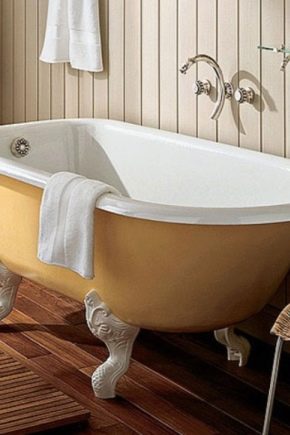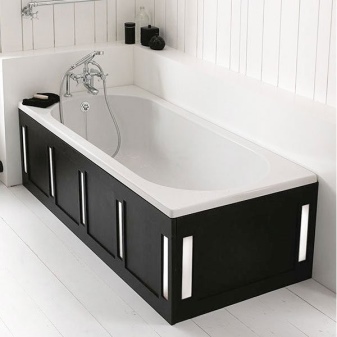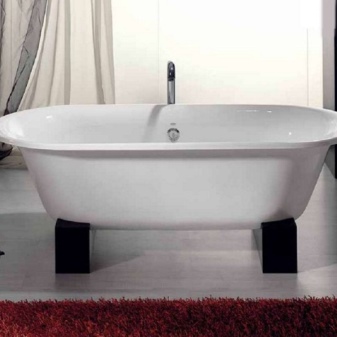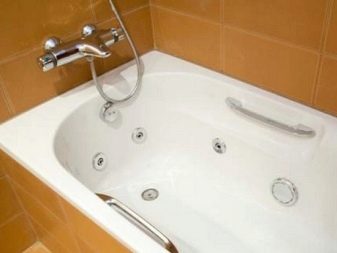How much do cast iron bathtubs weigh?

Despite the variety of acrylic bathtubs, cast-iron models do not give up their positions and remain in demand in the plumbing market. This is due to the reliability and durability of the structure, its attractive technical characteristics. A distinctive feature of a cast iron bath is its large weight, which is due to the high density of the alloy. Why is it important to take into account not only the dimensions, but also the weight of the structure, how to determine the approximate range of the mass of a standard or overall font: let's figure it out.


Material features and weight
Cast iron baths are characterized by a large margin of safety, which is due to the peculiarities of the product composition. Its basis is iron compounds with carbon, represented by graphite or cement. Reliability and resistance to mechanical damage have a direct impact on the service life of cast iron products. Most manufacturers call it a 30-year period of operation. However, in practice, this period is often 2-3 times longer.
The cast iron bowl is resistant to stress and vibration. This allows you to combine it with hydromassage equipment. It is worth noting the high thermal insulation properties of the material. The water in such a bath cools down extremely slowly. The enamel coating of the cast-iron hot tub is characterized by smoothness and absence of pores. This guarantees high antibacterial properties of the product, as well as the ability of the surface to self-cleaning. The bath is pleasant to the touch, it heats up quickly.


The peculiarities of the composition determine the large weight of the cast-iron bath, which in rare cases is less than 100 kg. If we talk about dimensional hot tubs filled with water, their weight can reach 500 kg.
The weight of the product should be taken into account not only when calculating the cost and transportation features of the purchased bath. It is much more important to calculate the bearing capacity of the floors. A heavy cast iron bathtub cannot be installed in buildings with dilapidated and wooden floors.
A small bathtub can be a challenge for wooden floors. A standard tub weighs 110 kg. If you fill it with water, then the mass will be 160 kg. To add here the weight of an adult man who intends to use the bowl is another 80 kg. It turns out that the load on the floors in this case will be 240 kg. Wooden floors that do not have a special overlap are capable of withstanding 16-240 kg. In other words, buying a standard bath and using it can provoke a critical load on the floors.


You should not consider heavy weight solely as a disadvantage. Due to the impressive mass, cast iron bowls are durable, durable and stable. They will not roll over and do not crack at the points of contact with the walls under the influence of vibrations.
The large weight of the cast iron bath is due to the high density of the alloy (7200 kg / m3). However, the presence of carbon makes the alloy brittle; therefore, cast iron baths have thick walls (up to 8-10 mm).
Standard parameters
The weight of the bath depends on its size and the volume of the bowl. In accordance with the dimensions, it is customary to distinguish three types of cast iron bowls.

Small
A typical size for such products is considered to be 120x70 cm. These compact models are optimal for small spaces, especially if you use corner bowls. Their weight is 77-87 kg with a bowl volume of 145-155 liters.

Standard
The length of such a bath is usually 150 cm, there are products with a length of 160 cm.Standard sizes are considered to be 150x70 or 160x70 cm.Such designs are suitable for bathrooms in standard apartments, they make the procedure for taking a bath more comfortable. If the user is forced to sit in a small hot tub, it is possible to take a reclining position in standard bathtubs. The weight of such devices is 92-120 kg with a bowl volume of 160-182 liters.

Large
The sizes of such fonts are usually 170x70 (170x75 cm) and 180x80 cm. Their length starts from 170 cm and can reach 200 cm. Such a bowl weighs from 120 kg. The weight shown is the weight of the "bare" cast iron bath. When installing, add the weight of the plumbing (if the mixer is mounted on the side of the bathroom), additional equipment (for example, a hydromassage system), water and a person. A 1.5-liter bath is considered standard, the volume of which is 162-169 liters. Its weight ranges from 90-97 kg.
With an increase in the length and width of the font, its volume and weight change. Usually cast iron baths of the same size weigh differently depending on the model. Rectangular wall structures have the least weight. Corner fonts, free-standing oval and round fonts are heavy.


Weight of old models
Imported sizes are mostly 15-20 kg lighter than domestic counterparts. As a rule, this is not due to the reduced size of the baths. For example, the depth of bathtubs of European brands rarely reaches 40 cm (usually the length from the bottom to the overflow hole is 35-38 cm), while the depth of the Russian analogue is 45-60 cm.The thickness of the walls of imported analogs is sometimes 2 times thinner than the thickness of the walls of the baths Russian production. On average, it is 6-7 mm. If we talk about inexpensive Chinese models, it can reach 5 mm.
The weight is also influenced by the thickness of the walls. Old models from the times of the USSR are distinguished by thicker walls. However, for modern models for high-quality functioning, a wall thickness of 1 cm is sufficient. The weight of old Soviet baths was regulated by GOST. For baths of a standard size of 150 x 70 cm, a weight of 102 kg was provided. There were also lightweight versions of the models that weighed 98 kg.


Thus, the difference in weight between Soviet and modern domestic counterparts is due to different wall thicknesses (the walls of modern models of bathtubs are thinner) and the enamel coating (it is now less applied). In this regard, the weight of modern bowls has decreased by 6-8 kg. The weight of a product of the same size may vary from manufacturer to manufacturer. For example, a bathtub measuring 150 × 70 cm, manufactured by Laguna-Lux (Russia), has a weight of 104 kg. The same product of the Roca brand weighs 73 kg.
Today, lightweight cast iron baths can be found on sale. They can be 10-50 kg lighter than standard cast iron bowls. This is due to a decrease in the thickness of the walls and bottom.
When buying such a model, it should be understood that it has a shorter service life - 10-15 years and is subject to mechanical damage. However, knowing the difference will allow the buyer to approach the issue of choosing a quality product in more detail.


What to choose?
When choosing a model of a cast-iron bathtub, you should pay attention to the area of the bathroom and the peculiarities of the load on the floors of the house. When buying a small bathtub, you don't have to worry. Its weight is permissible for wooden houses. It is important to pay attention to the depth of the product.
Too deep will be inconvenient for the elderly, children and the disabled. The optimal depth for this group of people is considered to be a product with an indicator of 35-37 cm. For an adult, a comfortable depth is 50-60 cm. It is believed that a bathtub should occupy no more than 1/3 of the room and should not block access to walls or other plumbing fixtures.
When buying, you should pay attention to the surface of the product. It should be even, smooth, uniform over the entire surface of the bath. The opening of the drain pipe must be compatible with the communications of the bowl. Pay attention to the weight based on the size of the bowl and the approximate requirements for a bath of this size.


Some manufacturers mislead the buyer by indicating the total weight of the bathtub, including legs and fittings. This makes it possible to achieve an increase in the weight coefficient and even surpass the indicators of similar Soviet baths in this. However, this is not correct. In addition to the size and weight, it is useful for a potential buyer to know the thickness of the walls of the bowl. If they are 5-6 mm, and the manufacturer indicates the mass of a standard one and a half meter bath equal to 95 kg, this should be a reason for a more thorough study of the product.
Try to find in the accompanying documents data on the weight of components and plumbing (if any included). If such information is not available, the buyer should think about why the manufacturer is silent about these indicators. This means that you have already included the weight of the accessories and components in the total weight of the bath.


Manufacturers
The purchase of a bowl of a well-known brand that enjoys consumer confidence will eliminate the risk of buying a low-grade bath. There are several of these manufacturers.
- Roca (Spain). Bowls from this manufacturer are distinguished by thick walls, have an enamel coating with the addition of titanium, which provides additional strength and non-slip. A standard bath 150 x 70 weighs an average of 73 kg.
- Jacob Delafon (France). The brand is represented by a variety of models, most of them have a depth of 40 cm and more, which is familiar to the Russian consumer. The weight of the bowl varies from 90 to 145 kg.


- Universal (Russia, Novokuznetsk). The products are presented by fonts in several sizes. The weight of the bowls is 90-122 kg.
- Recor (Portugal). The brand's products are made semi-antique, have shapes and designs characteristic of a retro style. The weight of the 170x75 cm model can reach 150 kg.


For information on how to install a Roca cast iron bathtub, see the following video.













The comment was sent successfully.